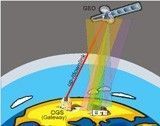PAGE CONTENTS
Objectives
This study investigates optical technologies and techniques that could, in a reliable manner, enable high-data-rate optical links through the atmosphere. Scenarios of interest are bidirectional feeder links between ground and a GEO satellite. Those optical technologies and techniques selected during the trade off are incorporated in the conceptual design of future ground-space optical communication links, and the impact of these solutions at system level (on both, ground and space segments) is assessed. The expected performances of the proposed links are derived based on simulation models taking into account atmospheric effects.
The general objective is to improve the performance and the reliability of high-data-rate optical communication links through the atmosphere. To this end, we investigate new optical technologies and techniques that have the potential to mitigate the propagation impairments caused by atmospheric effects. Proposed reliability measures will be adapted to communication feeder links between terrestrial gateways and GEO telecom satellites for applications such as future data relay and broadband access multimedia.
The proposed system shall:
- Provide a satisfactory link availability for the given application.
- Limit turbulence-induced impairments and/or make the link robust with respect to signal fades.
- Be described accurately by the identification of the requirements of subsystems and interfaces description. The conceptual design of the link and terminals shall pave the way for development and manufacturing.
Optical feeder link for a multi-beam satellite system
Challenges
The following key issues are addressed in the project:
- Laser wavelength,
- Modulation of optical signal,
- Number and location of ground stations for cloud mitigation,
- Multiplexing techniques for increase of capacity,
- Aperture sizes of ground and space terminals,
- Selection of reliable components.
Plan
The project is divided in the following successive tasks:
- Definition of the scenarios for future high-capacity feeder links, identification of the requirements.
- Assessment of optical technologies and techniques for reliable optical communications through the atmosphere.
- Trade-off of assessed optical technologies and techniques.
- System design of reliable high-capacity optical feeder links through the atmosphere.
Current Status
The ORELIA project has been completed.
A proof of concept is presented for the feasibility of high-capacity and high-reliability optical feeder links through the atmosphere. Various transmission techniques are evaluated with respect to their performance, cost, risk and schedule. The technology retained shares some properties with terrestrial fiber links: 1550 nm with wavelength multiplexing (WDM). Beside WDM, spatial multiplexing (over ground stations) is also considered. Selected techniques for cloud mitigation are OGS diversity and adaptive data rate. The availability of various European networks is assessed. Turbulence mitigation in the downlink is achieved with adaptive optics or a telescope array so that single-mode detection can be achieved. For the uplink, Tx-diversity was chosen over predistortion-AO because of its higher turbulence mitigation capability. Focus is on non-coherent detection. A conceptual design of the terminals, on ground and on the GEO satellite, is then provided. Development costs are estimated and a technical roadmap is proposed.




